Spatial and Temporal Analysis of Rainfall Concentration Using the Gini Index and PCI
Abstract
:1. Introduction
2. Materials and Methods
3. Results
4. Conclusions
Acknowledgments
Author Contributions
Conflicts of Interest
References
- Puertas, O.; Carvajal, Y.; Quintero, M. Estudio de tendencias de la precipitación mensual en la cuenca Alta-Media del Río Cauca, Colombia. Dyna 2011, 78, 112–120. [Google Scholar]
- Intergovernmental Panel on Climate Change (IPCC). Contribution of Working Groups I, II and III to the Fifth Assessment Report of the Intergovernmental Panel on Climate Change; Pachauri, R.K., Meyer, L.A., Eds.; Climate Change 2014: Synthesis Report; IPCC: Geneva, Switzerland; p. 151.
- Singh, D.; Tsiang, M.; Rajaratnam, B.; Diffenbaugh, N.S. Precipitation extremes over the continental United States in a transient, high-resolution, ensemble climate model experiment. J. Geophys. Res. Atmos. 2013, 118, 7063–7086. [Google Scholar] [CrossRef]
- Zubieta, R.; Saavedra, M. Distribución espacial del índice de concentración de precipitación diaria en los Andes centrales peruanos: Valle del río Mantaro. Tecnia 2009, 19, 13–22. (In Spanish) [Google Scholar] [CrossRef]
- Pizarro, R.; Valdés, R.; García-Chevesich, P.; Vallejos, O.; Sangüesa, C.; Morales, C.; Balocchi, F.; Abarza, A.; Fuentes, R. Latitudinal analysis of rainfall intensity and mean anual precipitation in Chile. Chil. J. Agric. Res. 2012, 72, 252–261. [Google Scholar] [CrossRef]
- Organización de las Naciones Unidas para la Educación, la Ciencia y la Cultura (UNESCO). Documento País “Análisis de Riesgos de Desastres en Chile 2010”. VI Plan de Acción Dirección General de Ayuda Humanitaria y Protección Civil (DIPECHO) en Sudamérica. Available online: http://dipecholac.net/docs/files/315-documento-pais-chile-2010.pdf (accessed on 14 November 2011). (In Spanish).
- Garreaud, R. Cambio Climático: Bases Físicas e Impactos en Chile. Available online: http://dgf.uchile.cl/rene/PUBS/inia_RGS_final.pdf (accessed on 14 November 2011). (In Spanish).
- Montecinos, A.; Díaz, A.; Aceituno, P. Seasonal diagnostic and predictability of rainfall in subtropical South America based on tropical Pacific SST. J. Clim. 2000, 13, 746–758. [Google Scholar] [CrossRef]
- Gonzáles, A. Ocurrencia de eventos de sequías en la ciudad de Santiago de Chile desde mediados del siglo XIX. Revista de geografía Norte Grande 2016, 64, 21–32. [Google Scholar] [CrossRef]
- Ortlieb, L. Las mayors precipitaciones históricas en Chile central y la cronología de eventos ENOS en los siglos XVI-XIX. Rev. Chil. Hist. Nat. 1994, 67, 463–485. [Google Scholar]
- Escobar, F.; Aceituno, P. Influencia del fenómeno ENSO sobre la precipitación nival en el sector Andino de Chile central durante el invierno. Bulletin de L’institut Français D’études Andines 1998, 27, 753–759. (In Spanish) [Google Scholar]
- González, A.; Muñoz, A. Cambios en la precipitación de la ciudad de Valdivia (Chile) durante los últimos 150 años. Bosque 2013, 34, 191–200. [Google Scholar] [CrossRef]
- Acosta-Jamett, G.; Gutiérrez, J.; Kelt, D.; Meserve, P.; Previtali, M. El Niño Southern Oscillation drives conflict between wild carnivores and livestock farmers in a semiarid area in Chile. J. Arid Environ. 2016, 126, 76–80. [Google Scholar] [CrossRef]
- González-Reyes, Á.; McPhee, J.; Christie, D.; Le Quesne, C.; Szejner, P.; Masiokas, M.; Crespo, S. Spatiotemporal Variations in Hydroclimate across the Mediterranean Andes (30°–37° S) since the Early Twentieth Century. J. Hydrometeorol. 2017, 18, 1929–1942. [Google Scholar] [CrossRef]
- Valdés-Pineda, R.; Valdés, J.; Diaz, H.; Pizarro, R. Analysis of spatio-temporal changes in annual and seasonal precipitation variability in South America-Chile and related ocean–atmosphere circulation patterns. Int. J. Climatol. 2013, 36, 2979–3001. [Google Scholar] [CrossRef]
- Barrett, B.S.; Garreaud, R.D.; Falvey, M. Effect of the Andes Cordillera on Precipitation from a Midlatitude Cold Front. Mon. Weather Rev. 2009, 137, 3092–3109. [Google Scholar] [CrossRef]
- Montecinos, A.; Kurgansky, M.V.; Muñoz, C.; Takahashi, K. Non-ENSO interannual rainfall variability in central Chile during austral winter. Theor. Appl. Climatol. 2011, 106, 557–568. [Google Scholar] [CrossRef]
- Organización de las Naciones Unidas para la Educación, la Ciencia y la Cultura (UNESCO). Documento País “Análisis de Riesgos de Desastres en Chile 2012”. VII Plan de Acción Dirección General de Ayuda Humanitaria y Protección Civil (DIPECHO) en Sudamérica 2011–2012. Available online: http://www.unesco.org/fileadmin/MULTIMEDIA/FIELD/Santiago/pdf/Analisis-de-riesgos-de-desastres-en-Chile.pdf (accessed on 14 November 2011).
- Favier, V.; Falvey, M.; Rabatel, A.; Praderio, E.; López, D. Interpreting discrepancies between discharge and precipitation in high-altitude area of Chile’s Norte Chico region (26–32° S). Water Resour. Res. 2009, 45, W02424. [Google Scholar] [CrossRef]
- Sarricolea, P.; Romero, H. Variabilidad y cambios climáticos observados y esperados en el Altiplano del norte de Chile. Revista de geografía Norte Grande 2015, 62, 169–183. [Google Scholar] [CrossRef]
- Rubio-Álvarez, E.; McPhee, J. Patterns of spatial and temporal variability in streamflow records in south central Chile in the period 1952–2003. Water Resour. Res. 2010, 46, W05514. [Google Scholar] [CrossRef]
- Monjo, R.; Martin-Vide, J. Daily precipitation concentration around the world according to several indices. Int. J. Climatol. 2016, 36, 3828–3838. [Google Scholar] [CrossRef]
- Yin, Y.; Xu, C.-Y.; Chen, H.; Li, L.; Xu, H.; Li, H.; Jain, S. Trend and concentration characteristics of precipitation and related climatic teleconnections from 1982 to 2010 in the Beas River basin, India. Glob. Planet. Chang. 2016, 145, 116–129. [Google Scholar] [CrossRef]
- Oliver, J. Monthly precipitation distribution: A comparative index. Prof. Geogr. 1980, 32, 300–309. [Google Scholar] [CrossRef]
- Pizarro, R.; Cornejo, F.; González, C.; Macaya, K.; Morales, C. Análisis del comportamiento y agresividad de las precipitaciones en la zona central de Chile. Ingeniería hidráulica en México 2008, 23, 91–110. (In Spanish) [Google Scholar]
- Martín-Vide, J. Spatial distribution of a daily precipitation concentration index in peninsular Spain. Int. J. Climatol. 2004, 24, 959–971. [Google Scholar] [CrossRef]
- Sarricolea, P.; Martin-Vide, J. Distribución Espacial de las Precipitaciones en Chile Mediante el Índice de Concentración a Resolución de 1 mm, Entre 1965–2005; Climático, C., Impacto, E., Eds.; Spanish Climatology Association: Salamanca, Spain, 2012; pp. 631–639. (In Spanish) [Google Scholar]
- Sarricolea, P.; Herrera, M.; Araya, C. Análisis de la concentración diaria de las precipitaciones en Chile central y su relación con la componente zonal (subtropicalidad) y meridiana (orográfica). Investig. Geogr. Chile 2013, 45, 37–50. [Google Scholar] [CrossRef]
- De Luis, J.; González-Hidalgo, M.; Brunneti, M.; Longares, A. Precipitation concentration changes in Spain 1946–2005. Nat. Hazards Earth Syst. Sci. 2011, 11, 1259–1265. [Google Scholar] [CrossRef] [Green Version]
- Li, X.; Jiang, F.; Li, L.; Wang, G. Spatial and temporal variability of precipitation concentration index, concentration degree and concentration period in Xinjiang, China. Int. J. Climatol. 2011, 31, 1679–1693. [Google Scholar] [CrossRef]
- Rajah, K.; O’Leary, T.; Turner, A.; Petrakis, G.; Leonard, M.; Westra, S. Changes to the temporal distribution of daily precipitation. Geophys. Res. Lett. 2014, 31, 8887–8894. [Google Scholar] [CrossRef]
- Rojas, O.; Mardones, M.; Arumí, J.L.; Aguayo, M. Una revisión de inundaciones fluviales en Chile, período 1574–2012: Causas, recurrencia y efectos geográficos. Revista de geografía Norte Grande 2014, 57, 177–192. [Google Scholar] [CrossRef]
- Westra, S.; Alexander, L.; Zwiers, F. Global Increasing Trends in Annual Maximum Daily Precipitation. J. Clim. 2013, 26, 3904–3918. [Google Scholar] [CrossRef]
- O’Gorman, P. Precipitation extremes under climate change. Curr. Clim. Chang. Rep. 2015, 1, 49–59. [Google Scholar] [CrossRef] [PubMed]
- Asadieh, B.; Krakauer, N. Impacts of changes in precipitation amount and distribution on water resources studied using a model rainwater harvesting system. J. Am. Water. Resour. Assoc. 2016, 52, 1450–1471. [Google Scholar] [CrossRef]
- Organización de las Naciones Unidas para la Educación, la Ciencia y la Cultura (UNESCO). Atlas of Arid and Semi Arid Zones of Latin America and the Caribbean; Technical Documents of the UNESCO PHI-LAC, N25; UNESCO: Montevideo, Uruguay, 2010; ISBN 978-92-9089-164-2. [Google Scholar]
- Kottek, M.; Grieser, J.; Beck, C.; Rudolf, B.; Rubel, F. World map of the Köppen-Geiger classification updated. Meteorologische Zeitschrift 2006, 15, 259–263. [Google Scholar] [CrossRef]
- Peel, M.C.; Finlayson, B.L.; McMahon, T.A. Updated world map of the Köppen-Geiger climate classification. Hydrol. Earth Syst. Sci. 2007, 11, 1633–1644. [Google Scholar] [CrossRef]
- Spavorek, G.; De Jong, Q.; Dourado, D. Computer assisted Koeppen climate classification: A case study for Brazil. Int. J. Climatol. 2007, 27, 257–266. [Google Scholar] [CrossRef]
- Ministerio de Medio Ambiente y Medio Rural y Marino (MARM). Atlas Climático Ibérico; Agencia Estatal de Meteorología (Spain); Instituto de Meteorología de Portugal: Madrid, Spain, 2011; ISBN 978-7837-079-5.
- Kalvová, J.; Halenka, T.; Bezpalcová, K.; Nemešová, I. Köppen climate types in observed and simulated climates. Stud. Geophys. Geod. 2003, 47, 185–202. [Google Scholar] [CrossRef]
- Pizarro, R.; Ausensi, P.; León, L.; Aravena, D.; Sangüesa, C.; Balocchi, F. Evaluación de métodos hidrológicos para la completación de datos faltantes de precipitación en estaciones de la región del Maule, Chile. Aqua-LAC 2009, 1, 172–184. (In Spanish) [Google Scholar]
- Alexandersson, H. A homogeneity test applied to precipitation data. Int. J. Climatol. 1986, 6, 661–675. [Google Scholar] [CrossRef]
- Organización de las Naciones Unidas para la Alimentación y la agricultura (FAO). Inequality Analysis: The Gini Index; FAO: Roma, Italy, 2005. [Google Scholar]
- Schultz, R.E.; Maharaj, R.; Lynch, S.D.; Howe, B.J.; Melvil-Thomsam, B. African Atlas of Agrohydrology and Climatology. Section 4 Precipitation. 1997. Available online: http://www.iwmi.cgiar.org/pubs/working/wor76_sect2.pdf (accessed on 4 June 2007).
- Helsel, D.; Hirsch, R. Statistical Methods in Water Resources: Book 4, Chapter A3; U.S. Geological Survey: Reston, VA, USA, 1992.
- Ahmad, I.; Tang, D.; Wang, T.; Wang, M.; Wagan, B. Precipitation Trends over Time Using Mann-Kendall and Spearman’s rho Tests in Swat River Basin, Pakistan. Adv. Meteorol. 2015, 2015, 431860. [Google Scholar] [CrossRef]
- Song, X.; Song, S.; Sun, W.; Mu, X.; Wang, S.; Li, J.; Li, Y. Recent changes in extreme precipitation and drought over the Songhua River Basin, China, during 1960–2013. Atmos. Res. 2015, 157, 137–152. [Google Scholar] [CrossRef]
- Yue, S.; Pilon, P.; Cavadias, G. Power of the Mann-Kendall and Spearman’s rho tests for detecting monotonic trends in hydrological series. J. Hydrol. 2002, 259, 254–271. [Google Scholar] [CrossRef]
- Jacques-Coper, M.; Garreaud, R. Characterization of the 1970s climate shift in South America. Int. J. Climatol. 2015, 35, 2164–2179. [Google Scholar] [CrossRef]
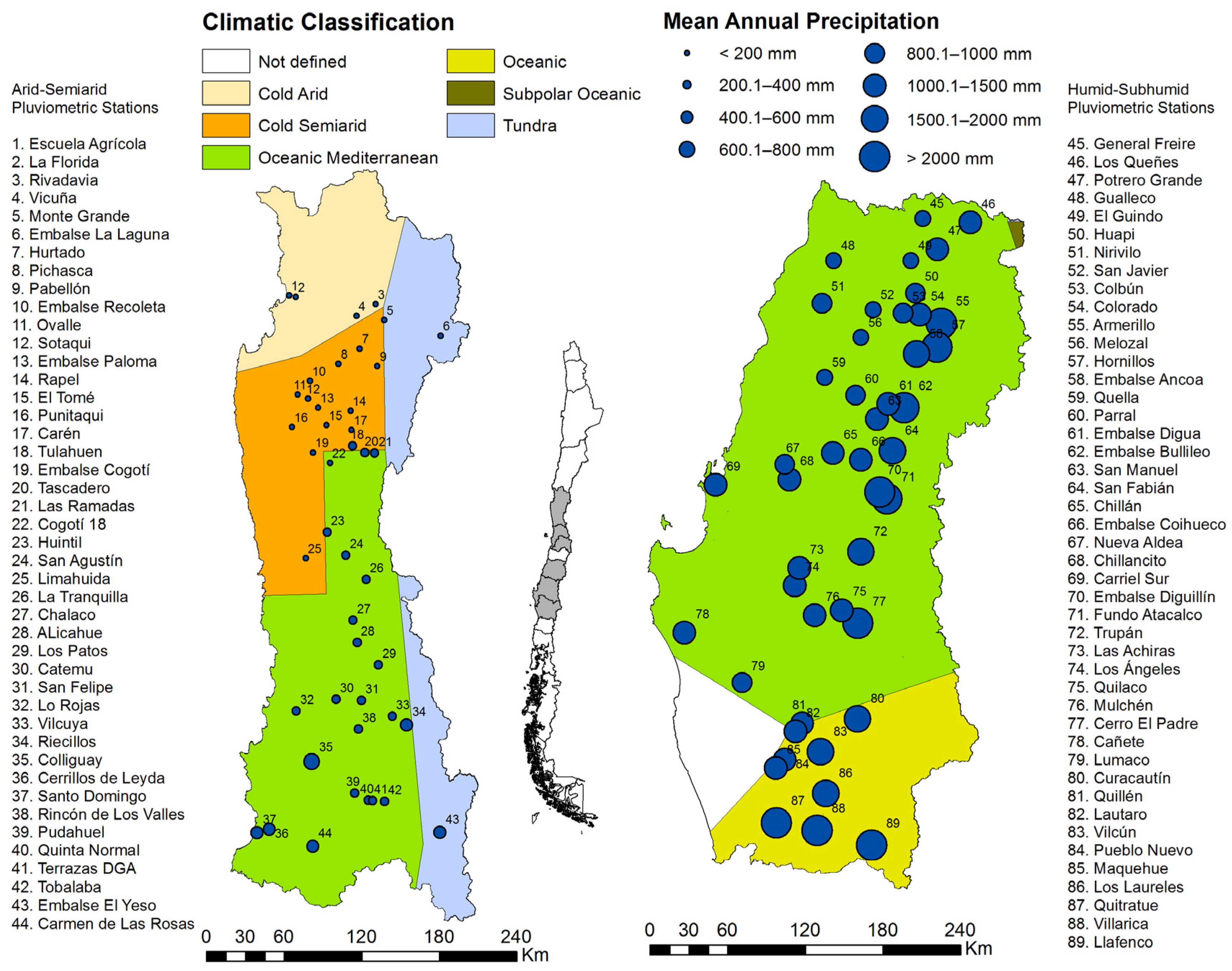

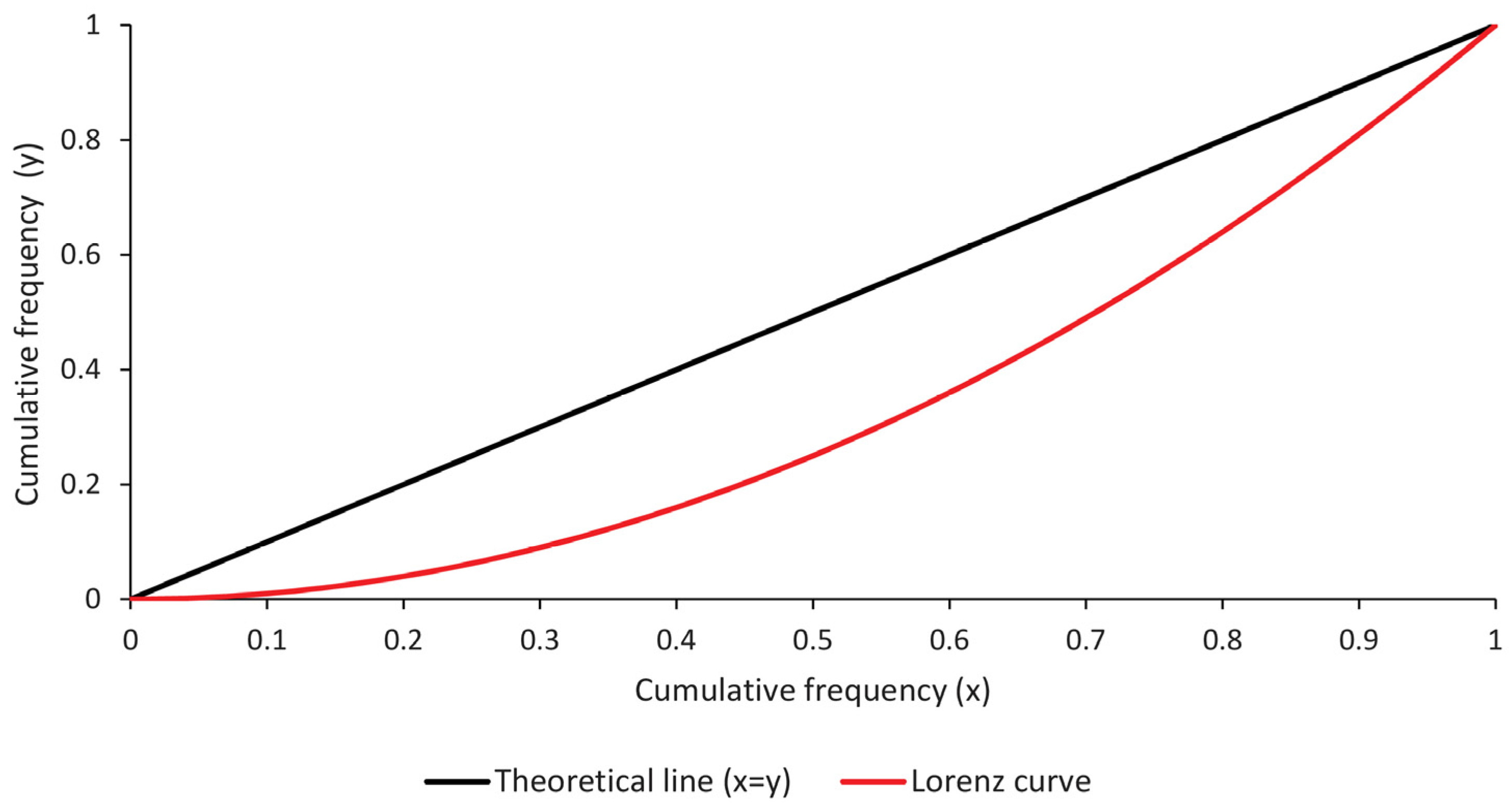

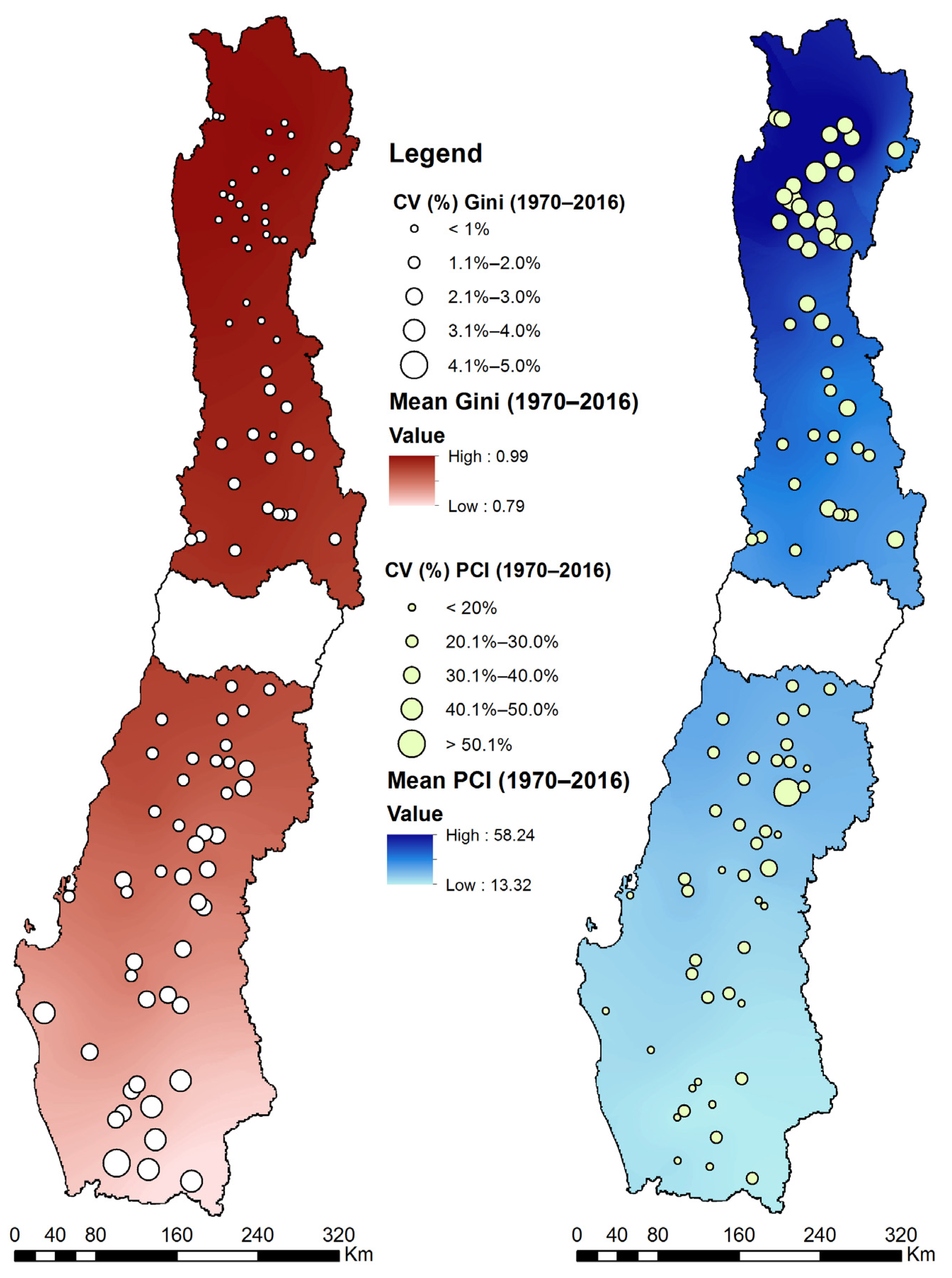
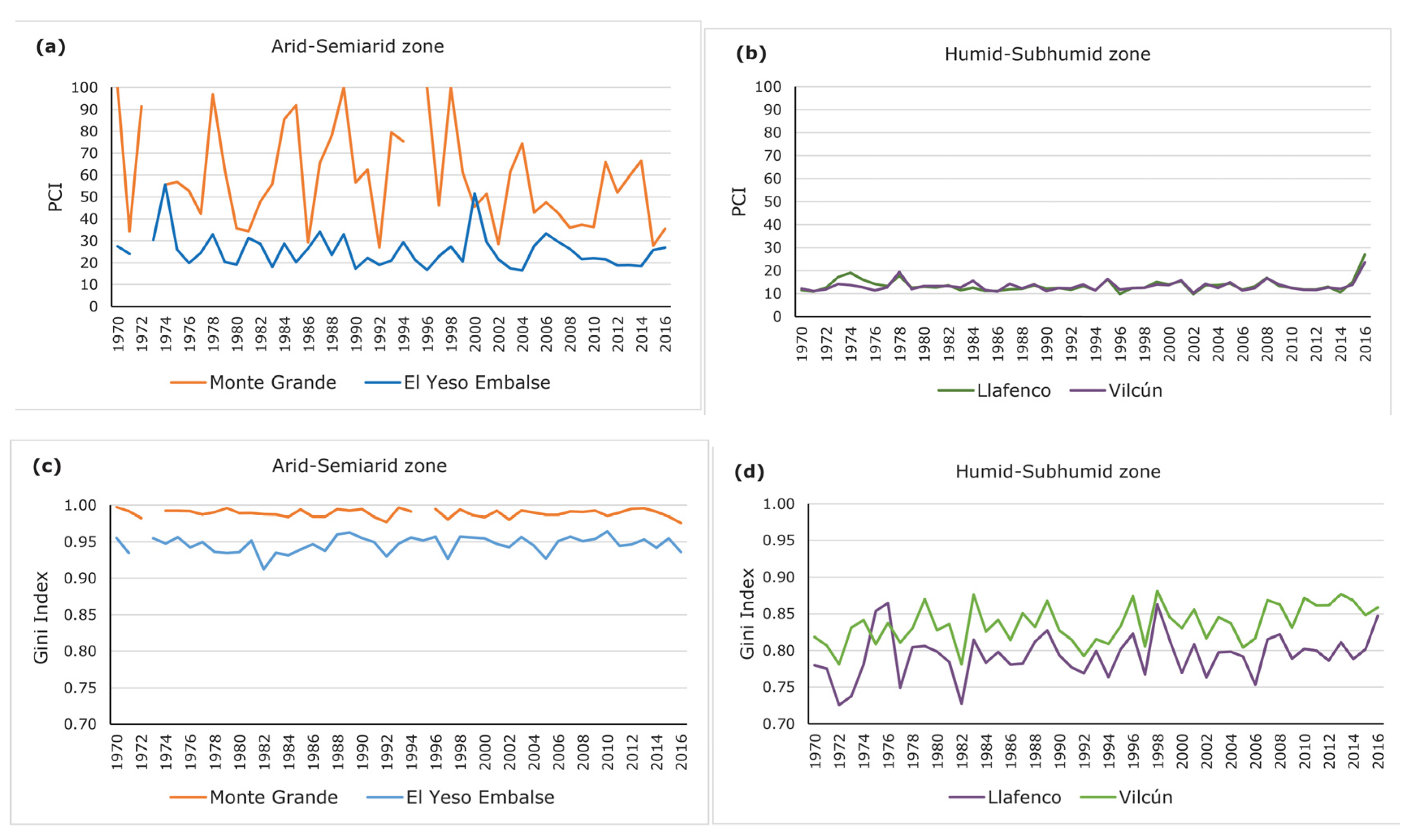
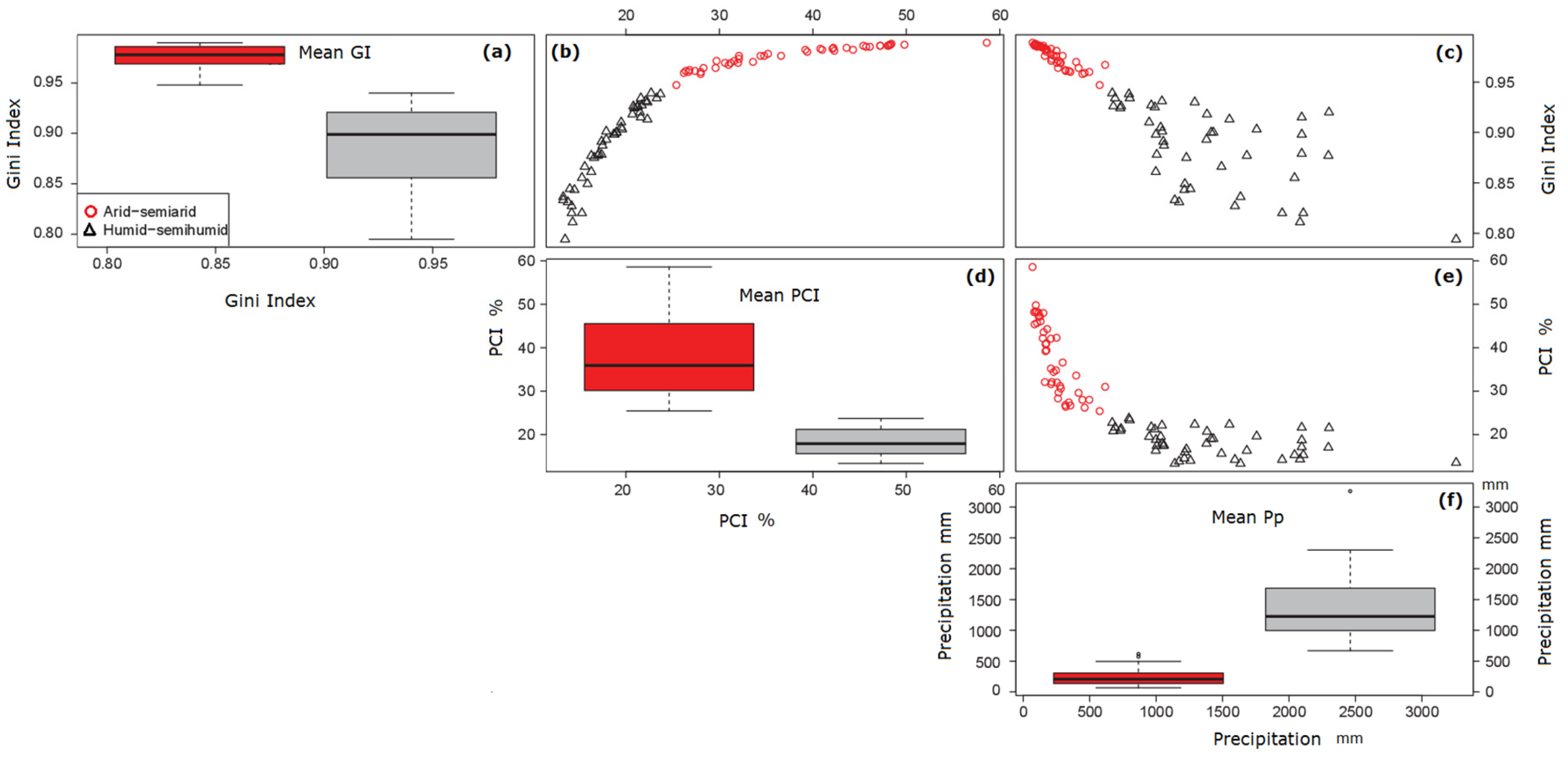
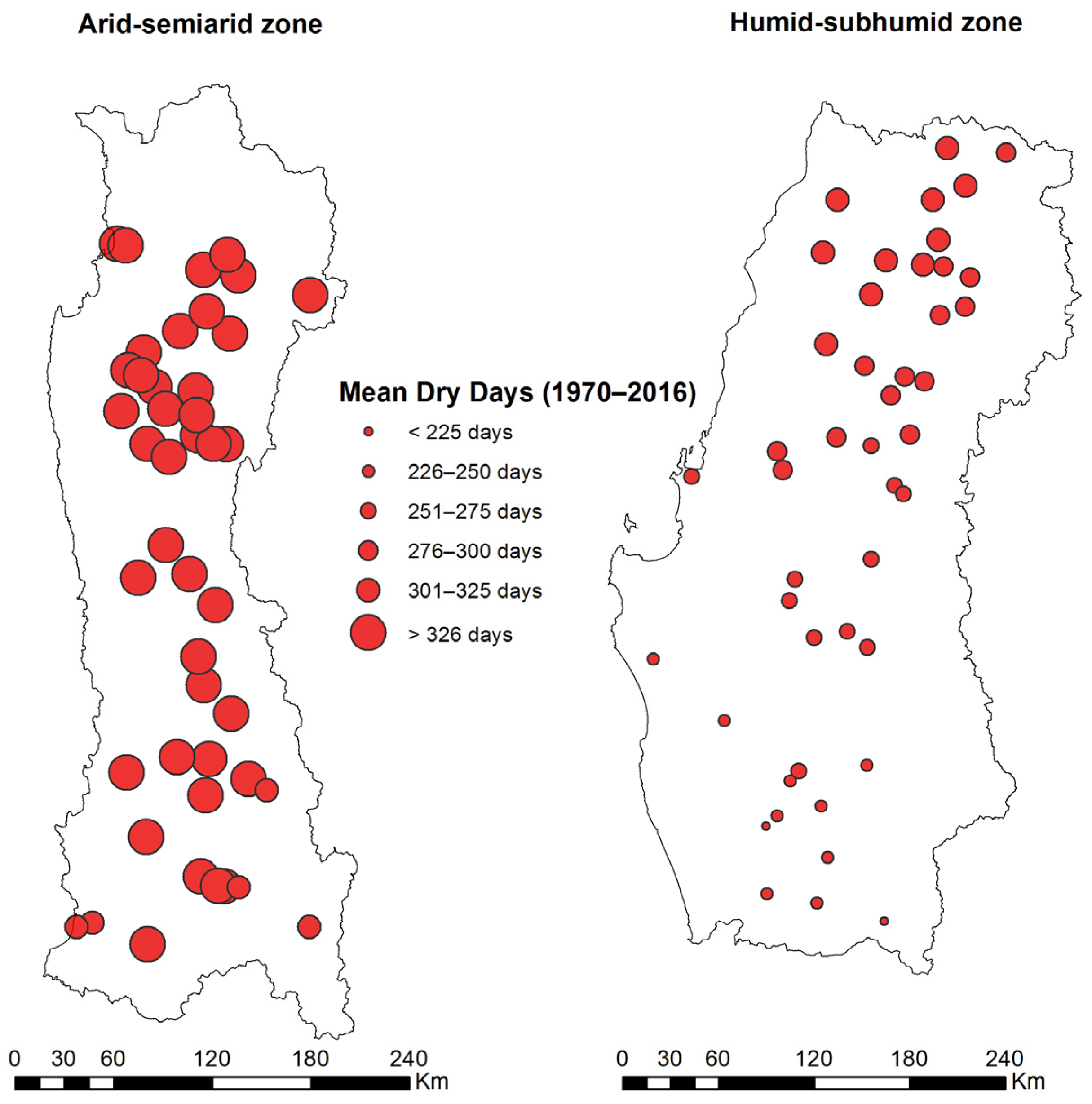
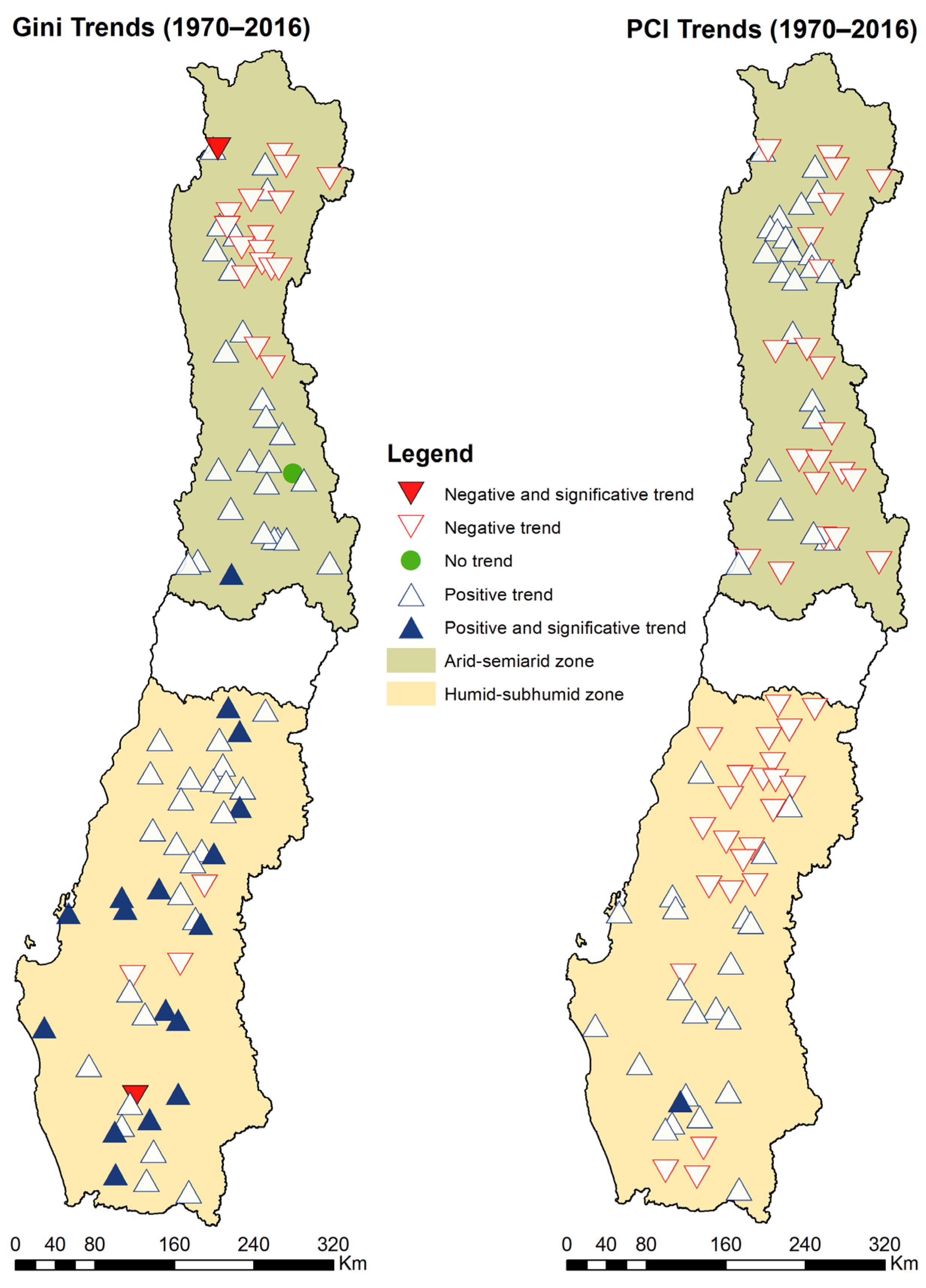
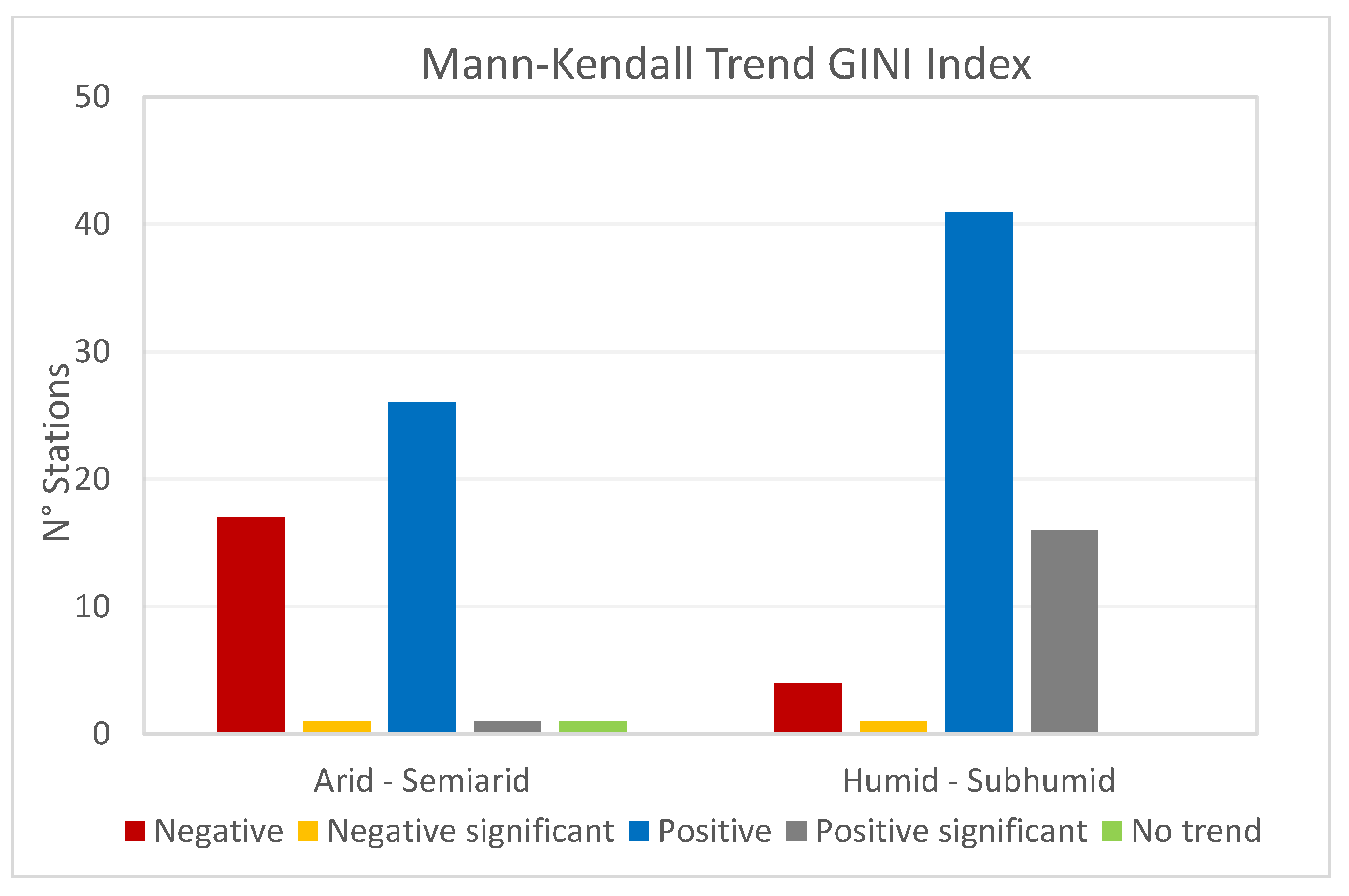

| Zone | Index | Gini | PCI | PP |
|---|---|---|---|---|
| Arid–semiarid | Gini | 0.91 * | −0.83 * | |
| PCI | 0.91 * | −0.74 * | ||
| PP | −0.83 * | −0.74 * | ||
| Humid–subhumid | Gini | 0.86 * | −0.41 * | |
| PCI | 0.86 * | −0.32 * | ||
| PP | −0.41 * | −0.32 * |
| Zone | Period | Negative | Negative Significant | Positive | Positive Significant | No Trend |
|---|---|---|---|---|---|---|
| Arid–semiarid | summer | 140 (53.0%) | 1 (0.4%) | 114 (43.2%) | 4 (1.5%) | 10 (3.8%) |
| winter | 129 (48.9%) | 4 (1.5%) | 132 (50.0%) | 3 (1.1%) | 3 (1.1%) | |
| Humid–subhumid | summer | 210 (77.8%) | 9 (3.3%) | 57 (21.1%) | 0 (0%) | 3 (1.1%) |
| winter | 175 (64.8%) | 27 (10.0%) | 94 (34.8%) | 10 (3.7%) | 1 (0.4%) |
© 2018 by the authors. Licensee MDPI, Basel, Switzerland. This article is an open access article distributed under the terms and conditions of the Creative Commons Attribution (CC BY) license (http://creativecommons.org/licenses/by/4.0/).
Share and Cite
Sangüesa, C.; Pizarro, R.; Ibañez, A.; Pino, J.; Rivera, D.; García-Chevesich, P.; Ingram, B. Spatial and Temporal Analysis of Rainfall Concentration Using the Gini Index and PCI. Water 2018, 10, 112. https://doi.org/10.3390/w10020112
Sangüesa C, Pizarro R, Ibañez A, Pino J, Rivera D, García-Chevesich P, Ingram B. Spatial and Temporal Analysis of Rainfall Concentration Using the Gini Index and PCI. Water. 2018; 10(2):112. https://doi.org/10.3390/w10020112
Chicago/Turabian StyleSangüesa, Claudia, Roberto Pizarro, Alfredo Ibañez, Juan Pino, Diego Rivera, Pablo García-Chevesich, and Ben Ingram. 2018. "Spatial and Temporal Analysis of Rainfall Concentration Using the Gini Index and PCI" Water 10, no. 2: 112. https://doi.org/10.3390/w10020112







